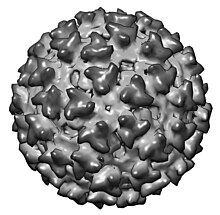Sindbis virus
| Sindbis virus | |
|---|---|

| |
| Virus classification | |
| (unranked): | Virus |
| Realm: | Riboviria |
| Kingdom: | Orthornavirae |
| Phylum: | Kitrinoviricota |
| Class: | Alsuviricetes |
| Order: | Martellivirales |
| Family: | Togaviridae |
| Genus: | Alphavirus |
| Species: | Sindbis virus
|
Sindbis virus (SINV) is a member of the
SINV is an arbovirus, it is arthropod-borne, and it is maintained in nature by transmission between vertebrate (bird) hosts and invertebrate (mosquito) vectors. Humans are infected with Sindbis virus when bitten by an infected mosquito.
Virus physiology
Structure, genome & replication
Sindbis viruses are enveloped particles with an icosahedral
A
Recombination has been demonstrated between RNAs of Sindbis virus.[6][7] The mechanism of recombination appears to be template switching (copy choice) during RNA replication.[6][7]
See also
References
- MicrobiologyBytes: Togaviruses
- CDC: Pogosta disease and Sindbis virus
- Sindbis virus—ICTVdB—The Universal Virus Database, version 4.
- PMID 23898184.
- PMID 31142666.
- ^ Kurkela S, Manni T, Vaheri A, Vapalahti O. Causative agent of Pogosta disease isolated from blood and skin lesions, Emerg Infect Dis [serial on the Internet]. Published 2004 May. (accessed 2007-10-16)
- ^ "Facts about Sindbis fever". European Centre for Disease Prevention and Control. Retrieved 7 September 2021.
- PMID 11720292.
- ^ PMID 1579113.
- ^ PMID 2072444.
